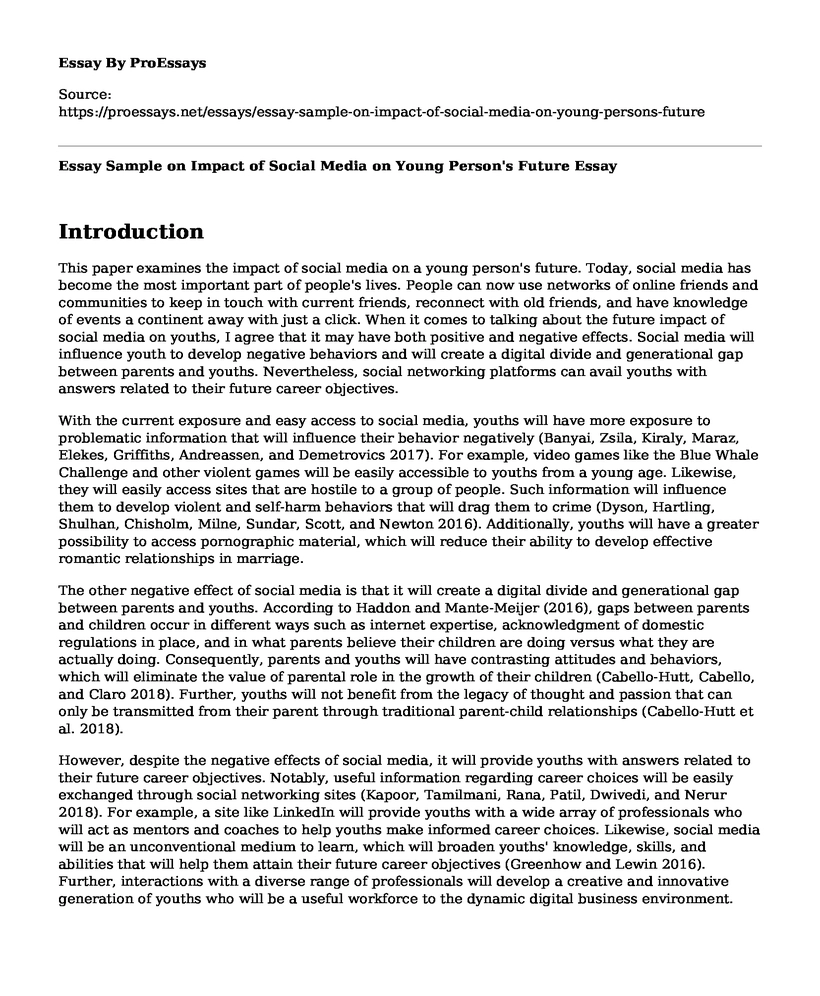Introduction
This paper examines the impact of social media on a young person's future. Today, social media has become the most important part of people's lives. People can now use networks of online friends and communities to keep in touch with current friends, reconnect with old friends, and have knowledge of events a continent away with just a click. When it comes to talking about the future impact of social media on youths, I agree that it may have both positive and negative effects. Social media will influence youth to develop negative behaviors and will create a digital divide and generational gap between parents and youths. Nevertheless, social networking platforms can avail youths with answers related to their future career objectives.
With the current exposure and easy access to social media, youths will have more exposure to problematic information that will influence their behavior negatively (Banyai, Zsila, Kiraly, Maraz, Elekes, Griffiths, Andreassen, and Demetrovics 2017). For example, video games like the Blue Whale Challenge and other violent games will be easily accessible to youths from a young age. Likewise, they will easily access sites that are hostile to a group of people. Such information will influence them to develop violent and self-harm behaviors that will drag them to crime (Dyson, Hartling, Shulhan, Chisholm, Milne, Sundar, Scott, and Newton 2016). Additionally, youths will have a greater possibility to access pornographic material, which will reduce their ability to develop effective romantic relationships in marriage.
The other negative effect of social media is that it will create a digital divide and generational gap between parents and youths. According to Haddon and Mante-Meijer (2016), gaps between parents and children occur in different ways such as internet expertise, acknowledgment of domestic regulations in place, and in what parents believe their children are doing versus what they are actually doing. Consequently, parents and youths will have contrasting attitudes and behaviors, which will eliminate the value of parental role in the growth of their children (Cabello-Hutt, Cabello, and Claro 2018). Further, youths will not benefit from the legacy of thought and passion that can only be transmitted from their parent through traditional parent-child relationships (Cabello-Hutt et al. 2018).
However, despite the negative effects of social media, it will provide youths with answers related to their future career objectives. Notably, useful information regarding career choices will be easily exchanged through social networking sites (Kapoor, Tamilmani, Rana, Patil, Dwivedi, and Nerur 2018). For example, a site like LinkedIn will provide youths with a wide array of professionals who will act as mentors and coaches to help youths make informed career choices. Likewise, social media will be an unconventional medium to learn, which will broaden youths' knowledge, skills, and abilities that will help them attain their future career objectives (Greenhow and Lewin 2016). Further, interactions with a diverse range of professionals will develop a creative and innovative generation of youths who will be a useful workforce to the dynamic digital business environment.
Conclusion
In summary, I support that social media will effect youths both negatively and positively in the future. In particular, through exposure to violent games, pictures, and pornographic content social media will influence youth to develop negative behaviors such as violence and poor intimate relationships. In addition, the digital divide and generational gap between parents and youths will increase further, which deny youths the benefits of the legacy of thought and passion that can only be transmitted from their parent through traditional parent-child relationships. Notwithstanding, social media will provide youths with answers related to their future career objectives, which will help them fit in the dynamic digital business environment. Notably, it is clear that social media will have more negative effects on youths than positive effects. Therefore, there is a need for youths to learn how to use social media in a healthy way.
References
Banyai, F., Zsila, A., Kiraly, O., Maraz, A., Elekes, Z., Griffiths, M.D., Andreassen, C.S. and Demetrovics, Z., 2017. Problematic social media use: Results from a large-scale nationally representative adolescent sample. PLoS One, 12(1), p.e0169839.
Cabello-Hutt, T., Cabello, P. and Claro, M., 2018. Online opportunities and risks for children and adolescents: The role of digital skills, age, gender and parental mediation in Brazil. new media & society, 20(7), pp.2411-2431.
Dyson, M.P., Hartling, L., Shulhan, J., Chisholm, A., Milne, A., Sundar, P., Scott, S.D. and Newton, A.S., 2016. A systematic review of social media use to discuss and view deliberate self-harm acts. PloS one, 11(5), p.e0155813.
Greenhow, C. and Lewin, C., 2016. Social media and education: reconceptualizing the boundaries of formal and informal learning. Learning, media and technology, 41(1), pp.6-30.
Haddon, L. and Mante-Meijer, E., 2016. Generational use of new media. Routledge.
Kapoor, K.K., Tamilmani, K., Rana, N.P., Patil, P., Dwivedi, Y.K. and Nerur, S., 2018. Advances in social media research: past, present and future. Information Systems Frontiers, pp.1-28.
Cite this page
Essay Sample on Impact of Social Media on Young Person's Future. (2022, Dec 04). Retrieved from https://proessays.net/essays/essay-sample-on-impact-of-social-media-on-young-persons-future
If you are the original author of this essay and no longer wish to have it published on the ProEssays website, please click below to request its removal:
- Western Beauty Gender's Influence on East Asian Females Essay
- Essay on Middle-Eastern Ethnicity Recognition
- Essay Sample on African & Asian Art: Impact on Modern Art Development
- The Elements and Principles of Design Essay
- Research Paper on Parent-Child Relationships: Shaping Future Lives
- Essay on Social Media in the Workplace: How Employers Can Guide its Use
- Western Sahara: Changes in Elderly and Working-Age Populations Since 1950 - Essay Sample







